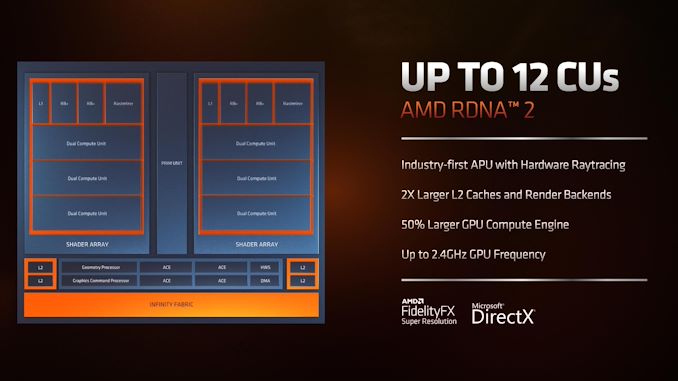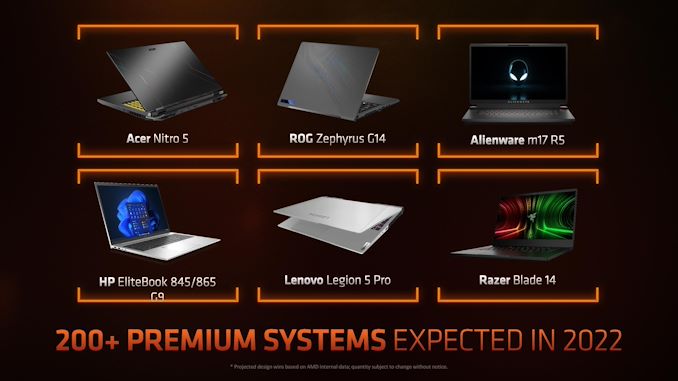AMD Announces Ryzen 6000 Mobile CPUs for Laptops: Zen3+ on 6nm with RDNA2 Graphics
by Dr. Ian Cutress on January 4, 2022 10:43 AM EST-page-011 - Copy_678x452.jpg)
The notebook market is a tough nut to crack with a single solution. People want that mix of high performance at the top, cost effectiveness at the bottom, and throughout there has to be efficiency, utility, and function. On the back of a successful ramp last year, AMD is striking the notebook market hot again in 2022 with the launch of its new Ryzen 6000 Mobile processors. These ‘Rembrandt’ APUs feature AMD’s latest RDNA2 graphics, up to eight Zen3+ cores with enhanced power management features, and it uses TSMC’s N6 manufacturing process for performance and efficiency improvements.
It’s all in the Silicon: Rembrandt is the Code-Name
Yesterday AMD disclosed that they would be launching the new Ryzen 6000 Mobile series today – updated cores, better graphics, more features, all in a single monolithic package a little over 200 mm2. There will be 10 new processors, ranging from the traditional portable 15 W and 28 W hardware, up to 35 W and 45 W plus for the high-end gaming machines. AMD is expecting 200+ premium systems in the market with Ryzen Mobile in 2022.
| AMD Ryzen 6000 Mobile CPUs 'Rembrandt' on 6nm |
||||||
| AnandTech | C/T | Base Freq |
Turbo Freq |
GPU CUs |
GPU MHz |
TDP |
| H-Series 35W+ | ||||||
| Ryzen 9 6980HX | 8/16 | 3300 | 5000 | 12 | 2400 | 45W+ |
| Ryzen 9 6980HS | 8/16 | 3300 | 5000 | 12 | 2400 | 35W |
| Ryzen 9 6900HX | 8/16 | 3300 | 4900 | 12 | 2400 | 45W+ |
| Ryzen 9 6900HS | 8/16 | 3300 | 4900 | 12 | 2400 | 35W |
| Ryzen 7 6800H | 8/16 | 3200 | 4700 | 12 | 2200 | 45W |
| Ryzen 7 6800HS | 8/16 | 3200 | 4700 | 12 | 2200 | 35W |
| Ryzen 5 6600H | 6/12 | 3300 | 4500 | 6 | 1900 | 45W |
| Ryzen 5 6600HS | 6/12 | 3300 | 4500 | 6 | 1900 | 35W |
| U-Series 15W-28W | ||||||
| Ryzen 7 6800U | 8/16 | 2700 | 4700 | 12 | 2200 | 15-28W |
| Ryzen 5 6600U | 6/12 | 2900 | 4500 | 6 | 1900 | 15-28W |
At the heart of the design is AMD’s Zen 3+ core, which affords an improvement in power management between the cores, but keeps the Zen 3 performance characteristics. The focus here is mainly to improve idle power consumption and power when using accelerators, to help extend the life of ultraportable devices – AMD is claiming 15-40% lower power between web browsing and video streaming. There is a frequency uplift as well, with the top processors going up to 5.0 GHz. AMD is claiming up to 1.3x Multi-thread performance for the Ryzen 7 6800U.
This is coupled with 12 compute units of the RDNA2 graphics engine, upgraded from eight Vega units. This is the widest integrated graphics engine that AMD has ever made, with both a +50% increase in units but also a fundamental change in the GPU design - double the graphics cache, double the rasterization performance, double the render backend, and hardware-accelerated ray tracing. The frequency also gets a +20% bump from 2.0 GHz to 2.4 GHz. In gaming performance at 15 W on 5800U vs 28 W at 6800U, AMD is claiming a 1.8-2.0x jump over the previous generation*, and anywhere from 1.2x to 3.0x at 1080p against the competition. Adding on FidelityFX Super Resolution, and AMD suggests another +20-60% in frame rates. This, combined with the memory improvements, should be good for integrated gaming. GPU Rendering performance according to AMD is up to 2.3x faster generationally, but it should be noted however that the GPU does support AV1 decode, both 8-bit and 10-bit streams.
* It should be noted AMD tested the 6800U at 28W nominal TDP, not 15 W
** We originally stated that Rembrandt did not support AV1 based on our interpretation of one of the slides from AMD - we have since confirmed that the chips do support AV1 decode, both 8-bit and 10-bit, supported by AMD's VCN IP inside the chip.
When paired with AMD’s new mobile graphics solutions, the 35W+ series of Rembrandt can feature AMD’s Advantage platform. The idea is that with an A+A design, the system can use SmartShift Max which allows for dynamic power adjustment between CPU and discrete GPU, leading to more performance. This can also be used to extend the battery life, or combined with AMD SmartAccess graphics, can be used to ensure the best GPU is used at all times.
The new Rembrandt CPUs will also feature updated memory controllers, with support up to DDR5-5200 and LPDDR5-6400 – it’s worth noting that there doesn’t seem to be DDR4 support here, thus making a clean cut to the DDR5 standards. (Ian: that might mean increased cost during the first few months of these products.) AMD has also increased from PCIe 3.0 to PCIe 4.0, supporting 8x for a discrete GPU and 12x split between NVMe, SATA, and chipset. There is also native support for USB4, which allows vendors to follow Thunderbolt 3 specifications if needed.
On accelerators and security, Rembrandt features Microsoft Pluton support, which has been in the pipe for a couple of years as a way to enable coupled security between system, the OS, and potentially the cloud. Features like protecting user memory are welcome, however there have been concerns that Pluton opens more doors than it closes, depending on your jurisdiction. On a lighter note, according to details in the firmware and open source drivers, Rembrandt will also include computer vision-based machine learning hardware – a pair each of the Tensilica Vision Q6 and C5 DSPs, which should offer more functionality around laptop cameras when put to good use. These sorts of mobile APUs also end up in embedded systems, such as augmented reality or automotive, which could extend the offering there.
On this announcement, it’s interesting to see that most of the comparison numbers AMD supplied to us were for the 15 W hardware, however 80% of the CPUs being launched today are focused more at the 35W and higher space. It will be interesting to see how the 35W+ performs by comparison, given that at 35W+ we expect to see most systems with a discrete GPU, and most of the Rembrandt enhancements were in the integrated graphics. Nonetheless, we’re going to see a lot of systems using Ryzen 6000 Mobile announced this week – AMD states that some of these should start going on sale around February.














77 Comments
View All Comments
nandnandnand - Tuesday, January 4, 2022 - link
FUD. It will do nothing to stop piracy or anything.at_clucks - Tuesday, January 4, 2022 - link
Every machine that would have shipped with this CPU comes with a TPM doing much the same work. Now it's no longer a discrete component but integrated into the CPU. Probably Pluton can do a bit more than the TPM but at its most basic it emulates TPM, things like SHACK.But in the end Pluton doesn't take away anything that wasn't already taken away by OEMs working closely with MS to make sure you can't boot a Linux on your machine "for security".
bernstein - Tuesday, January 4, 2022 - link
that's just FUD, you can put linux on any laptop.at_clucks - Wednesday, January 5, 2022 - link
You can but only if the distribution works with Secure Boot or after you disable it. You may find the odd package not installing because it's not signed, go through the enrollment process... But what I meant is that the mechanism is already there and if you rely on workarounds to use it then you're one step away from the moment when, in the interest of security, saving the children, and fighting the terrorists, it is locked down further. Microsoft has an outsized influence on the ecosystem and OEMs tend to rather go with their word.Pluton may also have workarounds and exploits but having to rely on that to do what you wanted to do is not a sustainable solution.
MS is trying to use the Xbox model on the PC, or at least follows in Apple's T-chip shaped footsteps. And while it may make sense on a console it certainly doesn't on a PC. The Xbox is a single purpose (gaming online without piracy or cheating) machine and it fits the purpose because it's locked down. The PC is a general purpose machine so anything that can obscure or prevent full access for you, the owner, is an erosion of that concept.But people now are more used to the mobile world where you get a completely locked down slab of hardware that's effectively obsolete after 3 years because between locked down bootloaders, unavailability of critical SoC drivers, and mechanisms used by the OS/app ecosystem to make sure you run an official ROM you will never have control over that device or be able to extract the full value of that device once the manufacturer decides you need to change it. So this makes people who grew up with this model ok with losing control over what they can execute on any of their machines.
ballsystemlord - Wednesday, January 5, 2022 - link
It might get that bad, but at first it's more likely that MS will use it to mine your PC for interesting data they can sell.The NSA will not be far behind. Pluton is just too good for them to ignore the opportunity.
at_clucks - Sunday, January 9, 2022 - link
You got it bad. MS already controls your OS, and most installations probably run on machines with TPM (Win11 requires it, Win 10 doesn't but can use it if it's there and it has ~3 years to live) so for all intents and purposes it's almost as if they had Pluton. So why the hell would they need Pluton to get anything from your machine? And how would a TPM like chip which *holds secrets* help them "mine your PC for interesting data"?ballsystemlord - Monday, January 10, 2022 - link
In order:1: You don't have to use windowz just because it's the default OS.
2: Because now they know all that is secret and have access to the PC remotely.
Go to the semiaccurate link, but be warned, Pluton is a black box so we only know the most basic stuff about it.
Qasar - Tuesday, January 11, 2022 - link
i hope MS starts to also sell MS branded tin foil hats soon.nandnandnand - Tuesday, January 4, 2022 - link
The big disappointment is that the 6-core Rembrandt chips only have 6 CUs. Particularly the 6600U which would be less likely to be paired with discrete graphics.The CPU performance increase is almost too good to be true. Needs more context. They said +11% in Cinebench which could be a combination of clocks and IPC.
AhsanX - Tuesday, January 4, 2022 - link
They compared CZN at 15W vs RMB at 28W.